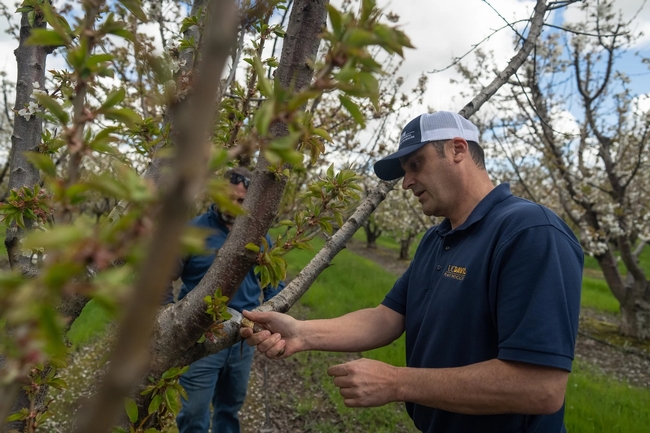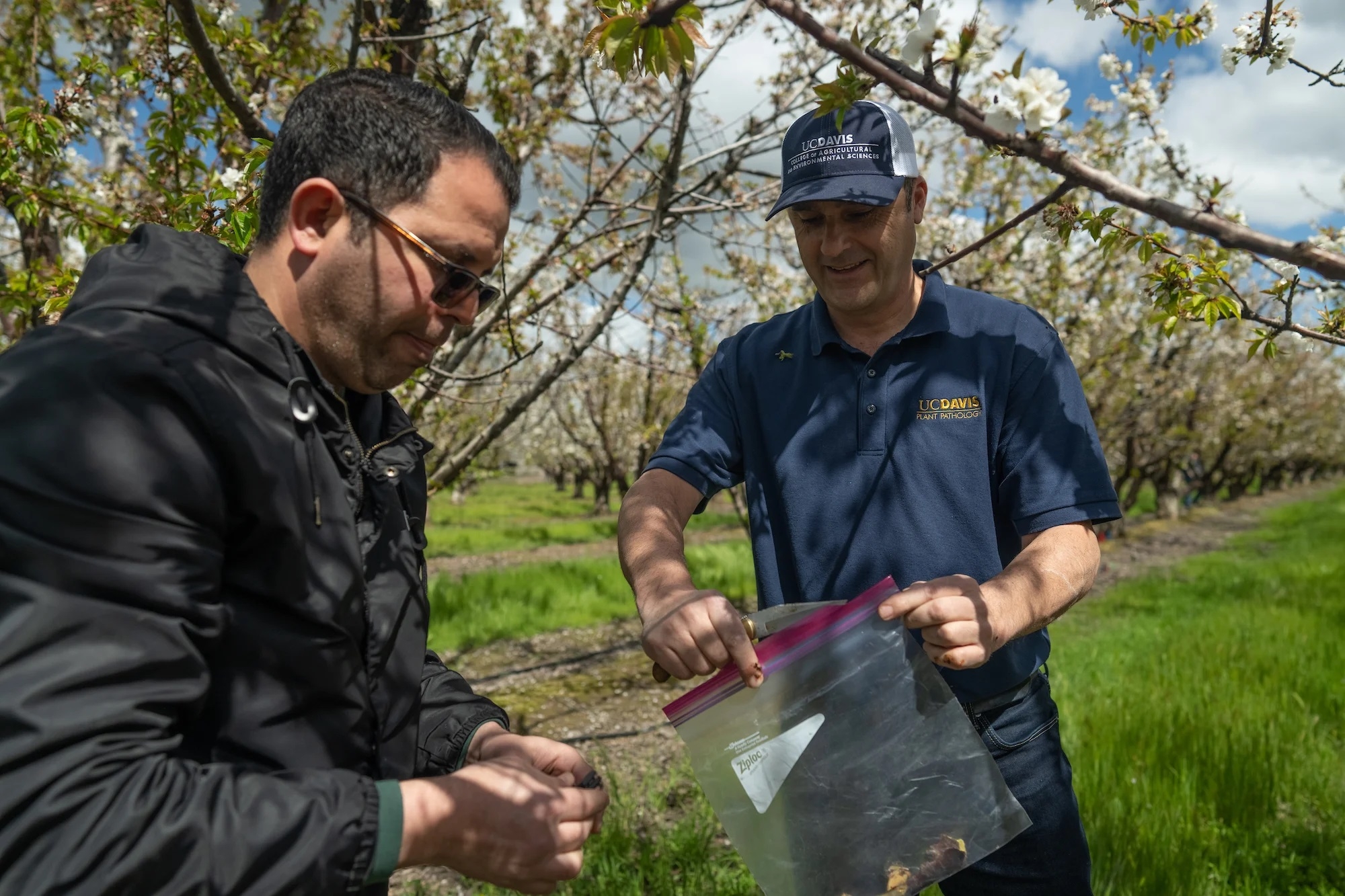Winter atmospheric rivers gave pathogens and diseases the path to infect crops
Epidemics similar to El Niño-influenced issues of the 1990s
The wave of atmospheric rivers that swept across the state this winter created favorable conditions for plant pathogens that had not been seen in decades in California. University of California, Davis, plant pathologist Florent "Flo" Trouillas is getting more and more calls from growers and agricultural advisers concerned about potential crop damage.
"Generally anytime you have rain events you're going to have problems," said Trouillas, a cooperative extension specialist who is based at the Kearney Agricultural Research and Extension Center in Parlier. "In wet years we are very busy because most pathogens need water and love water."
Trouillas is like a disease detective. He divides his time between the field and the lab, working to diagnose pathogens, diseases and other ailments that strike fruit and nut crops such as almonds, cherries, olives and pistachios.

Florent Trouillas, UC Cooperative Extension Specialist, examines a cherry tree in Lodi for potential pathogens. Photo by Jael Mackendorf, UC Davis
During a recent visit to an almond orchard near Fresno, Trouillas joined Mae Culumber, agricultural nut crop advisor for UC Cooperative Extension Fresno County. A few weeks earlier, the two men had been walking through the orchard, noticing the base of some trees that had gumming - a thick, jelly-like substance indicating that a pathogen had taken hold.
>"A lot of what Florent does is evaluate patterns on a landscape," Culumber said. "Sometimes things can seem like one thing, but it can be another problem."
When the two returned weeks later, the amber-colored gum had moved through the canopy, looking like balls of gum stuck to branches, some of which were already dead. "It got out of control compared to before," Trouillas said. “This branch has been killed. It's very common."
From the field to the laboratoryLab tests confirmed what Trouillas believed to be the culprit: Phytophthora syringae, a pathogen that can affect almond crops but is rarely seen in California. If found, infection sites are usually pruning wounds, but that is not the case here, where infection started in the canopy on twigs or small branches.< /p>
This is a threat to a key crop that the California Department of Food and Agriculture says generates $5 billion a year. The last time Phytophthora syringae hit California was in the 1990s after a series of El Niño-influenced storms. Trouillas, who has a photographic memory, remembered reading about it in an old textbook.

An almond tree near Fresno infected with the pathogen Phytophthora syringae. The pathogen is usually found in the roots of trees, but intense storms have created the right conditions for the pathogen to "climb" the trunks. Photo by Emily C. Dooley, UC Davis
"It's rare for California and it's the one we mostly see following atmospheric rivers," he says.
"Disease will only occur after these extremely wet winters."
Phytophthora occurs in the soil, is found primarily in tree roots, and does not usually spread through branches. But the intense storms created the perfect conditions for the pathogen to "swim" up the trunks as winds blew spores into the air and rain carried them back down into the canopy, Trouillas said. /p>
Some of the trees in this orchard will die; others can be saved by pruning infected branches and applying a recommended fungicide, he said.
Identification, diagnosis, educationTrouillas is one of more than 50 cooperative extension specialists at UC Davis and each is responsible for identifying problems and developing solutions to those problems in support of agriculture, ecosystem and communities throughout the state.
In his role, Trouillas focuses not only on pathology and research, but also on educating growers, nursery staff, pest management advisors, and other agriculture stakeholders on how to manage potential threats and prevent crop damage.

The wave of atmospheric rivers that swept across the state this winter created favorable conditions for plant pathogens that had not been seen in decades in California. University of California, Davis, plant pathologist Florent "Flo" Trouillas is getting more and more calls from growers and agricultural advisers concerned about potential crop damage.
"Generally anytime you have rain events you're going to have problems," said Trouillas, a cooperative extension specialist who is based at the Kearney Agricultural Research and Extension Center in Parlier. "In wet years we are very busy because most pathogens need water and love water."
Trouillas is like a disease detective. He divides his time between the field and the lab, working to diagnose pathogens, diseases and other ailments that strike fruit and nut crops such as almonds, cherries, olives and pistachios.

Florent Trouillas, UC Cooperative Extension Specialist, examines a cherry tree in Lodi for potential pathogens. Photo by Jael Mackendorf, UC Davis
During a recent visit to an almond orchard near Fresno, Trouillas joined Mae Culumber, agricultural nut crop advisor for UC Cooperative Extension Fresno County. A few weeks earlier, the two men had been walking through the orchard, noticing the base of some trees that had gumming - a thick, jelly-like substance indicating that a pathogen had taken hold.
>"A lot of what Florent does is evaluate patterns on a landscape," Culumber said. "Sometimes things can seem like one thing, but it can be another problem."
When the two returned weeks later, the amber-colored gum had moved through the canopy, looking like balls of gum stuck to branches, some of which were already dead. "It got out of control compared to before," Trouillas said. “This branch has been killed. It's very common."
From the field to the laboratoryLab tests confirmed what Trouillas believed to be the culprit: Phytophthora syringae, a pathogen that can affect almond crops but is rarely seen in California. If found, infection sites are usually pruning wounds, but that is not the case here, where infection started in the canopy on twigs or small branches.< /p>
This is a threat to a key crop that the California Department of Food and Agriculture says generates $5 billion a year. The last time Phytophthora syringae hit California was in the 1990s after a series of El Niño-influenced storms. Trouillas, who has a photographic memory, remembered reading about it in an old textbook.

An almond tree near Fresno infected with the pathogen Phytophthora syringae. The pathogen is usually found in the roots of trees, but intense storms have created the right conditions for the pathogen to "climb" the trunks. Photo by Emily C. Dooley, UC Davis
"It's rare for California and it's the one we mostly see following atmospheric rivers," he says.
"Disease will only occur after these extremely wet winters."
Phytophthora occurs in the soil, is found primarily in tree roots, and does not usually spread through branches. But the intense storms created the perfect conditions for the pathogen to "swim" up the trunks as winds blew spores into the air and rain carried them back down into the canopy, Trouillas said. /p>
Some of the trees in this orchard will die; others can be saved by pruning infected branches and applying a recommended fungicide, he said.
Identification, diagnosis, educationTrouillas is one of more than 50 cooperative extension specialists at UC Davis and each is responsible for identifying problems and developing solutions to those problems in support of agriculture, ecosystem and communities throughout the state.
In his role, Trouillas focuses not only on pathology and research, but also on educating growers, nursery staff, pest management advisors, and other agriculture stakeholders on how to manage potential threats and prevent crop damage.
What's Your Reaction?













![Three of ID's top PR executives quit ad firm Powerhouse [EXCLUSIVE]](https://variety.com/wp-content/uploads/2023/02/ID-PR-Logo.jpg?#)







